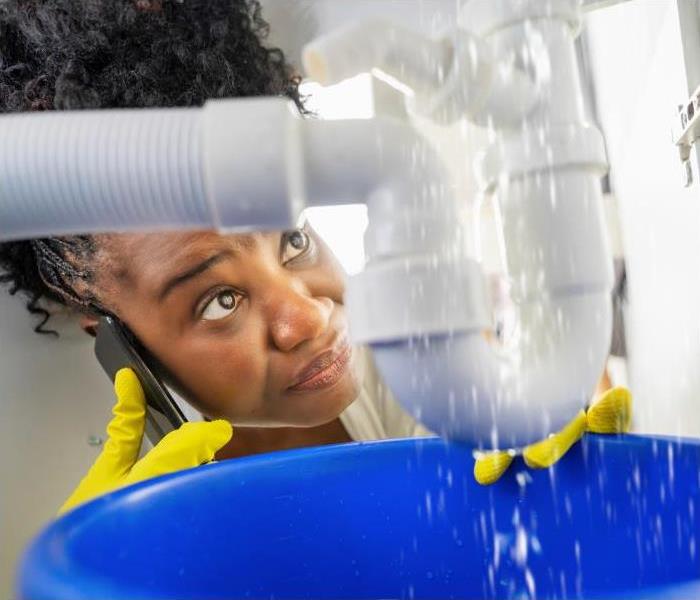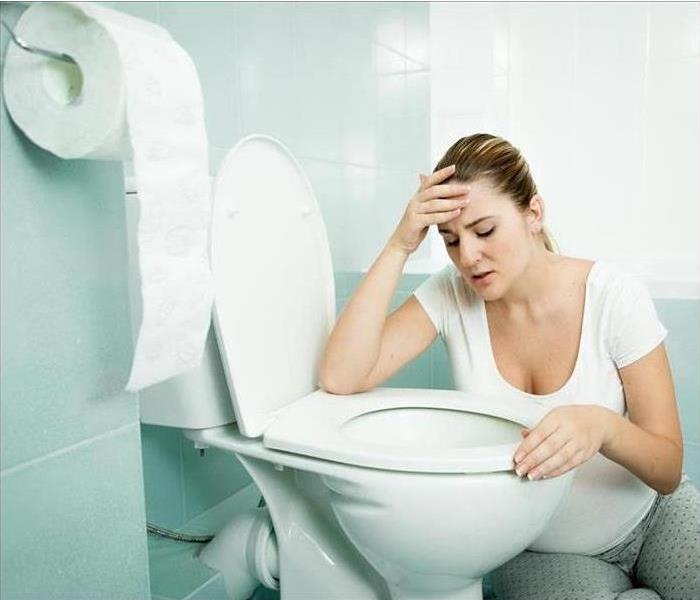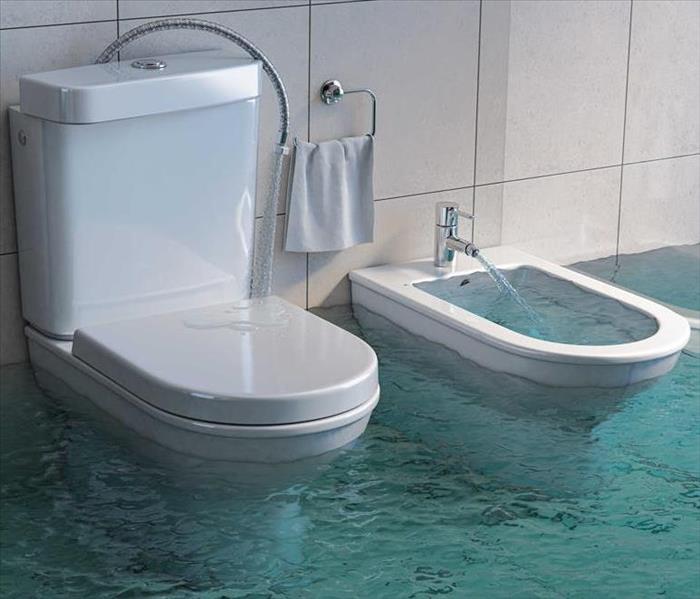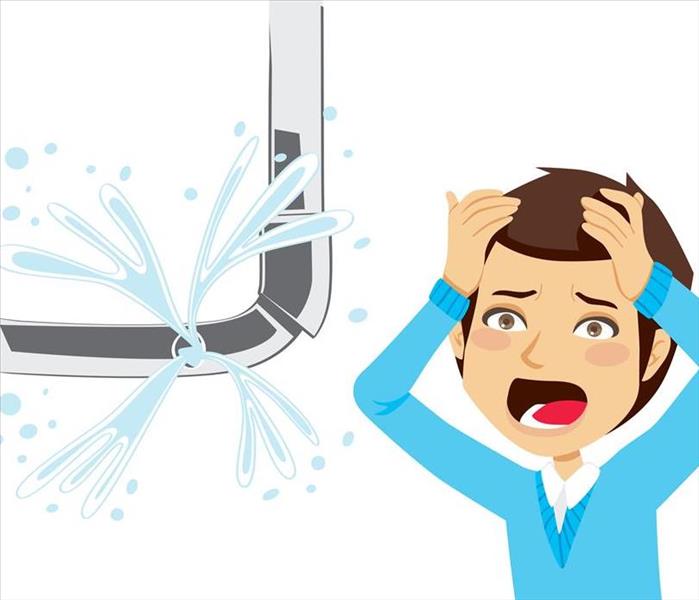Recent Water Damage Posts
Swift Solutions to Water Damage: SERVPRO of Sandy to the Rescue
1/13/2024 (Permalink)
 Leaking pipe in Sandy, Salt Lake City, Utah.
Leaking pipe in Sandy, Salt Lake City, Utah.
Water damage can strike at any moment, catching homeowners off guard and wreaking havoc on their property. One of the most common causes of water damage is a leaking pipe. Whether it's a slow and persistent drip or a sudden burst, the consequences can be devastating. However, acting swiftly is crucial to mitigating the damage and preventing long-term issues. In such situations, SERVPRO of Sandy emerges as a beacon of hope, providing immediate and effective solutions to address water damage caused by leaking pipes.
1. Understanding the Scope of Water Damage:
Before delving into the role of SERVPRO of Sandy, it's essential to comprehend the potential consequences of water damage stemming from a leaking pipe. Aside from obvious property damage, water intrusion can lead to mold growth, compromised structural integrity, and health hazards. It's a race against time to mitigate these risks, emphasizing the need for prompt action.
2. Immediate Response: The SERVPRO Advantage
SERVPRO of Sandy specializes in professional water damage restoration, offering a swift and comprehensive response to mitigate the effects of water damage. Their team of highly trained technicians understands the urgency of the situation and is equipped with the latest tools and technology to address the issue promptly.
3. Emergency Water Extraction:
The first step in the mitigation process is the extraction of standing water. SERVPRO of Sandy employs advanced water extraction equipment to swiftly remove water from the affected areas. This not only prevents further damage but also expedites the drying process.
4. Thorough Drying:
Once standing water is removed, the focus shifts to thorough drying of the affected spaces. SERVPRO utilizes industrial-strength dehumidifiers and high-powered air movers to eliminate moisture from walls, floors, and other surfaces. This prevents the onset of mold and mildew, safeguarding the indoor air quality.
5. Professional Assessment:
A crucial aspect of SERVPRO's service is a professional assessment of the extent of water damage. This assessment guides the restoration process, ensuring that no hidden pockets of moisture are left untreated. Their experts use moisture meters and thermal imaging technology to identify areas that may require special attention.
6. Mold Remediation:
Given enough time and moisture, mold can quickly become a secondary concern. SERVPRO of Sandy is well-versed in mold remediation techniques, addressing any mold growth resulting from the water damage. Timely intervention in this regard can prevent more significant issues down the line.
7. Structural Restoration:
In cases of severe water damage, structural components of a property may be compromised. SERVPRO of Sandy has the expertise and resources to handle structural restoration, ensuring that the property is returned to its pre-damage condition.
8. Content Restoration:
Water damage doesn't only affect the structure but also the contents within. SERVPRO employs specialized techniques for content restoration, salvaging belongings that may have otherwise been deemed unsalvageable.
9. Customer-Centric Approach:
SERVPRO of Sandy takes a customer-centric approach to water damage restoration. They understand the stress and disruption such events can cause, and their team is committed to providing compassionate and efficient service. Their communication is transparent, keeping homeowners informed at every step of the restoration process.
10. 24/7 Availability:
Water damage doesn't adhere to a schedule, and neither does SERVPRO of Sandy. Their emergency response team is available 24/7, ready to spring into action whenever disaster strikes. This prompt response can make all the difference in minimizing damage.
11. Insurance Coordination:
Navigating insurance claims can be a daunting task, especially in the aftermath of a crisis. SERVPRO of Sandy assists homeowners in the claims process, working with insurance companies to ensure a smooth and efficient resolution.
12. Preventive Guidance:
Beyond the immediate restoration, SERVPRO of Sandy offers preventive guidance to homeowners. This includes recommendations on how to safeguard against future water damage, whether through routine maintenance or the installation of protective measures.
Dealing with water damage resulting from a leaking pipe requires immediate and professional intervention. SERVPRO of Sandy stands out as a reliable partner in these challenging times, offering a swift and comprehensive response to mitigate the effects of water damage. Their expert team, advanced technology, and customer-centric approach make them a beacon of hope for homeowners facing the unexpected aftermath of a leaking pipe. When water damage strikes, SERVPRO of Sandy is the trusted ally to restore homes and peace of mind.
What To Do When Your Toilet Leaks With Every Flush
8/18/2023 (Permalink)
 Toilet leak can lead to several water damage in Sandy, UT.
Toilet leak can lead to several water damage in Sandy, UT.
Toilets are pretty hardy units. Those porcelain commodes remain sturdy and durable, usually lasting for decades after installation. However, like anything in the home, it can break down. When homeowners in Sandy, UT, observe a leaking toilet, they should take action.
A leak is a time to assess and react quickly. Small leaks can lead to significant problems such as water damage and mold. Therefore, owners shouldn't wait and see or put it off for another day. The following are tips for handling this situation.
- Understand the Common Causes of a Leaking Toilet
What is essentially wrong? Focus on this question as you begin your leak hunt. Water could escape from the toilet for many reasons; thus, learn the intricacies of the device and its various parts. For instance, any of the following situations could explain the mishap:
- Someone improperly installed it.
- The bowl or tank has a crack.
- The bolts are loose.
- The wax ring broke or dissolved.
- The base is weakly sealed.
- The wax ring is busted or old.
- Create a Plan To Locate the Main Issue
Find the bathroom leak by running some tests. Start with observation. When you flush, do you visually see when the drips or leaks happen? Where is the release? How much is coming out? For instance, you may observe water around the base with a weak wax ring or a bad flange. Check out those parts before moving to something else.
If that isn't the answer, tighten the bolts to see if the base needs more security. A wobbly seat may lead you to this option. Furthermore, drips may happen from the lines or minor breaks in the porcelain. Drop color-safe dissolvable tablets into the tank. Flush and keep your eyes open for color outside of the unit.
- Assess for Additional Water Damage
If water drips into the floor, walls or ceiling, the material soaks it up. This situation proves problematic for several reasons. When the fluid sits for long periods, it could harm the structure's integrity, beginning to weaken and rot. In addition, mold spores thrive on dampness. They exist everywhere and migrate through the air and the movement. If present, they reproduce in moist, organic substances. Thus, owners could find fungus growth with long-term leaks.
Call a professional water remediation team to assess the bathroom and surrounding area. These porous items permit dampness to go deep inside, reaching microscopic levels that dehumidifiers and bleach cannot reach. These experts evaluate the conditions and can create a plan to clean and restore the room. They may not fix the toilet, but they can attend to the secondary damage.
- Determine a Strategy to Resolve the Problem
Be sure to fix the origin of the water source. Once you know how it occurred, work with plumbers to correct the trouble. Buy new parts and ensure that specialists install them to avoid future issues.
When you push the handle down, water shouldn't come out. If you observe puddles or drips, then examine the unit for concerns. Determine the cause of your leaking toilet and repair the source of trouble.
Does Your Toilet Overflow When You Run the Shower? Clean the Mess With These Sewage Cleaning Tips
6/17/2022 (Permalink)
 Have a better Water Cleaning Experience following Our Tips.
Have a better Water Cleaning Experience following Our Tips.
When sewage lines become clogged, the obstruction prevents the fluid from moving through the pipes. It builds up, escaping from the nearest outlet. Sinks and toilets offer the most viable openings, so when you step into the shower and the plumbing is blocked, the water is likely to pour out of the toilet, leaving owners to handle sewage cleaning.
How To Manage Toilet Overflows and Sewage Cleaning
As a homeowner in Sandy, UT,, you need to protect your house and seek professional help for clean-up procedures. With a few tools and expert assistance, your shower and toilet can function correctly again. The following are three essential tips to follow.
1. Locate the Clog Causing the Toilet Overflow
Turn off the water to the immediate area. You don't want another overflow to occur while hunting down the source. Then, move from one location to another to find the blockage. The following are possible zones of trouble. Check each one to ensure that you catch any concerns.
- Drain Cleanout
- Outside sewage pipes
- Commode
Plungers work well for smaller obstacles. However, this clog is likely larger and further down the plumbing. For more efficiency, control and force, use a snake. Begin with the toilet. The snake is a long flexible tube that can enter the lines. It has a crank that creates pressure to push the clog through. You can move through the various home openings, testing for concerns.
If you can't find the issue, move to the drain cleanout. It's usually located outside. Wear gloves and use the torque to remove the lid. You're entering the main sewer line, filled with microorganisms and waste. If you're reached this point, it's best to call in a water restoration company in Sandy, UT, to assess the trouble.
2. Tackle Outside Troubles
After a while, older pipes corrode, weakening your structure. Also, tree roots can grow into lines, leaving cracks and holes. These permit sand and dirt to collect, blocking movement. The specialists have high-quality video scopes to scrutinize the plumbing. They can clean the drain out and identify external concerns. In addition, they begin necessary repairs.
3. Start Sanitizing and Sewage Cleaning Procedures
Sewer water is a class 3 fluid, also called black water. It's not something you want to stick around in your home because it hosts bacteria and mold. The longer it lingers, the more contamination you face. Spores such as mold, for instance, migrate into your porous materials like drywall and flooring. Mixed with the water, they reproduce quickly, infesting places within one to two days. Therefore, immediately work with the remediation team to initiate clean-up procedures once you've located the blockage.
Have the team assess the clogged pipe aftermath, collect samples and take moisture readings. Attack the fluid. Dry out the impacted spaces using industrial dehumidifiers and air scrubbers. Discard porous, overly saturated materials.
Deodorize and treat the bathroom with antimicrobial cleaners. Then, rebuild and replace the space, returning it to proper working order.
Running your shower can trigger the toilet to overflow if you have a clog. Shut off the water and find the source. A team of water experts can assist in your trouble and begin critical sewage cleaning. Don't wait. It's imperative to improve fluid movement and sanitize the space.
4 Ways To Avoid Water Damage During a Vacation
3/24/2022 (Permalink)
 When you return from Vacation, give your Home a good check-up by following these tips.
When you return from Vacation, give your Home a good check-up by following these tips.
After returning home from vacation, the sight of flood rooms or landscaping is never a welcome sight. Unfortunately, there are many potential causes of flooding, such as a damaged appliance, frozen pipes, or a leak in the roof. Heavy storms in the winter or summer could cause flooding in the basement or a faucet that was left on could lead to water damage.
If you want to avoid the expensive damage caused by water, you need to think beyond water pipe repair.
Avoid Water Damage by Checking Your Home
1. Thoroughly Check Pipes, Appliances, and Your Home
Begin your inspections several weeks before your vacation. You may need to flush the water heater, replace an appliance, or schedule water pipe repair, and this could take some time to complete. Watch out for hoses that appear damaged, seals that are worn, signs of rust, cracks, and clogged gutters and downspouts.
2. Turn Off Water to Your Home
Shutting off the water at the main is one of the best ways to avoid water damage from a broken pipe when you're on vacation. If you don't want to turn off all the water, shut it off behind toilets and appliances, as well as underneath sinks. Once you've turned off the water, open the faucets to drain any remaining water from the pipes.
3. Turn Off the Water Heater
The water heater in your home contains a lot of water. Some newer heaters have a vacation mode that provides some protection. However, if you plan to be gone for a long time, it's best to completely turn the water heater off, so you can avoid a flooded basement when you return.
4. Ask a Neighbor To Check In
There are several benefits to having a friend check your home while you're gone, such as picking up newspapers, mail, and packages. They can care for pets and make sure your home looks as if you were still at home.
Returning home to leaking pipes or having to face water pipe repair as well as flood damage may be one of the worst ways to end a vacation. Sandy, UT, water damage repair and reconstruction professionals may have other valuable tips.
Understanding Insurance Coverage When Your Basement Floods
2/17/2022 (Permalink)
 It is helpful to understand your homeowner's policy.
It is helpful to understand your homeowner's policy.
A basement flood can happen for a variety of reasons. An active storm season, a busted or frozen pipe, leaking appliances and invasive groundwater can all affect the lowest level of your home in Sandy, UT. When this happens, one of your first calls is likely to be your insurance provider, and it helps to know exactly what your homeowner's policy covers.
2 Things You Should Know About Insurance Coverage
1. Insurance Limits
Even if you have great property coverage, some things will still be out-of-pocket expenses. There are several types of damage that aren't typically covered by the standard homeowner's policy:
- Neglect - Rotting floorboards or drywall damage that happens due to an ongoing issue that you have failed to address in a timely manner is unlikely to be covered by your insurance. This is one of the reasons it's important to call water damage mitigation experts as soon as you notice a problem.
- Plumbing - While your insurance coverage on your home pays for repairs to the structure itself, it doesn't usually cover repair or replacement of the leaky plumbing components that cause the damage.
- Appliances - Likewise, your insurance policy doesn't pay to repair or replace broken appliances, which can also cause a flooded basement.
- Storm Flooding - The typical homeowner's insurance plan doesn't pay for damage repair after a storm. It is wise to get a separate flood policy to protect your home, particularly if you live in a flood plain or have a basement.
- Sewer Backup - A clog or break in the sewer line that leads to your home may result in a backup through a shower, bathtub, toilet or sink. Your property coverage may not pay for the subsequent damage, so a separate water backup policy is a good idea, particularly if you live in an older home or in an established neighborhood with a lot of trees.
2. Standard Coverage
If your basement flood is the result of a sudden, accidental incident, your homeowner's policy likely covers the mitigation of the water damage it leaves behind. This includes removal of damaged materials, water extraction, drying, disinfecting and restoration. Depending on how extensive your policy is, it may also pay for the recovery of some of your personal items, such as electronics or important documents.
While many policies share the same basic components, the only way to be sure of the terms of your specific coverage is to review the documents that outline its boundaries. Talk to your insurance agent if you need clarification. It is also a good idea to ask what risks you are taking that aren't covered by anything in your plan.
No matter how many preventative measures you take, a basement flood can still happen in your home. Knowing all the things that could cause it helps you decide what kind of coverage you need beyond the basic homeowner's package. Most of the structural damage may be covered by your plan, but you may have to pay for other repairs out of pocket. A thorough understanding of your homeowner's policy is helpful in deciding how much you need to save for a rainy day.



 24/7 Emergency Service
24/7 Emergency Service




